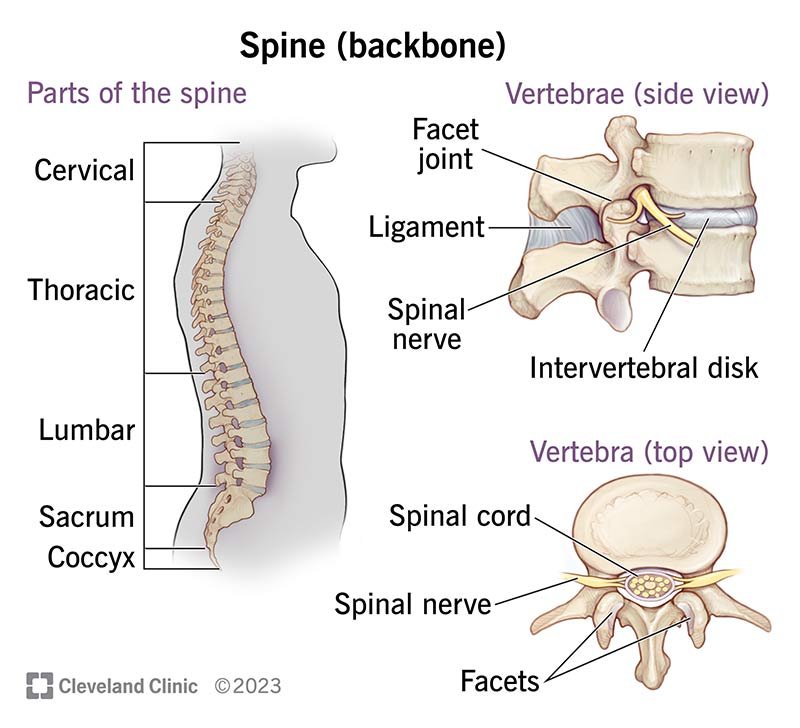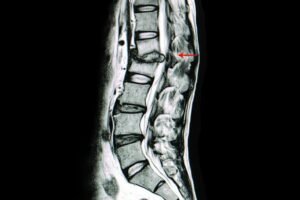Herniated Disks
In most cases, lower back injuries are especially tedious due to the body’s reliance on the spine and back for movement, rotation, and how it connects to other body parts, affecting its ability to heal and isolate itself. Yet despite this, they are extremely prevalent, with one statistic stating that 60 to 80% of people experience lower back pain at some point in their lives. One possible source of this pain? Herniated Disks.
What is it?:
Herniated disks, sometimes also known as bulging, protruding, or ruptured disks, is a condition that typically occurs on the lower spine and it is one of the most common causes of lower back pain and sciatica (pain that travels down the sciatic nerve, which goes down from the lower back to each leg). To better understand this condition, a general understanding of the spine and its disks is needed.
Understanding the Spine
The spine consists of 24 different bones, or vertebrae, spinal cord and nerves, and intervertebral disks. The spinal cord and nerves are responsible for carrying messages, signals, and sensations. Any damage to these body parts can impair movement and function. Because of how valuable it is to the body, it is protected by the 24 vertebrae stacked on top of one another. In between each vertebra is a flexible intervertebral disk, which allows for easy movement and is characterized as a shock absorber when walking, exercising, etc. Disks are flat, round, and usually half an inch thick, being composed of two main components: the annulus fibrosus, which is the tough, flexible outer ring of the disk, and the nucleus pulposus, which is the soft, jelly-like center. The bottom five vertebrates, also known as the lumbar spine, are what make up the lower back.
Diagram of the spine
A closer look at the intervertebral disc
Herniated disks
A disk becomes herniated when the nucleus pulposus pushes against the annulus fibrosus, creating pressure that may cause the ring to bulge, tear, or leak. When this occurs, the combination of the compression of the nerves and the release of chemicals from the disk results in nerve inflammation and, hence, lower back pain.
Symptoms:
Specific symptoms for a herniated disc along the lower back includes:
Back pain
Muscle weakness
Sciatica - sharp pain, numbness, or weakness in one/both of the legs
Loss of bladder and bowel control; may indicate more serious problem known as Cauda Equina Syndrome
Causes and Risk Factors:
Herniated Disks are typically a result of:
Age-related wear and tear - As people age, the water content in disks decreases, making them shrink, become less flexible, and reduce the space between vertebrae. This makes herniations more likely with older age.
Excessive Weight - Excessive weight can alter the spine's natural curve, creating additional stress on disks.
Gender - Males aged 20 to 50 are more likely to develop herniated disks.
Repetitive Motions - Repetitive motions put frequent stress on disks. This is why those with physically demanding jobs are especially susceptible to this condition.
Improper Lifting, Twisting, and Other Motions - Having improper technique when moving can make the back vulnerable, with most of the stress being applied to it rather than other stronger muscles throughout the body.
Traumatic Event - Sudden movements, falls, etc, can cause herniated disks.
Sedentary Lifestyle - Living a sedentary lifestyle or being inactive can weaken supporting muscles, putting unnecessary strain on the back.
Previously Herniated Disk - There is a 20 to 25% chance that a herniated disk will herniate again.
Smoking - Smoking can lead to more rapid degeneration of disks due to decreased oxygen supply.
Relation to Sports:
Similarly to those with physically demanding jobs, athletes who engage in high-impact sports, especially without proper technique and strength, are more prone to developing herniated disks. While suffering from one, engaging in such high-impact sports should be avoided at all costs, or it may not only worsen the condition and cause great pain but also lead to the development of improper technique. If the condition worsens, it may further compress the disc, nerves, and spine, potentially resulting in long-term damage or exponentially increased recovery time. Futhermore, even if it is not apparent or on purpose, the body will often shift how it moves to protect against further injury and pain. In doing so, other muscles and soft tissues may also become subsequently injured.
Sports to Avoid
Sports involving heavy weights, rotations, and bending of the spine should be especially avoided. The goal while healing is to not add further stress on the disk. High-impact activities should be avoided.
Some include:
Running
Jumping
Gymnastics
Weightlifting
Football
Rugby
Volleyball
Tennis
Basketball
Yoga - certain poses
Diving
Other high-impact activities
Sports to Play
While undergoing an injury, it is still important to exercise and incorporate movement into uninjured areas. Low-impact activities are recommended.
Some include:
Walking
Swimming
Biking
Other low-impact activities.
When returning to the sport, slowly transition back into it to retrain potentially weakened muscles and ensure full recovery of disks.
Diagnosis:
To diagnose this condition, healthcare professionals will utilize a variety of tests, including:
Discuss symptoms and Medical History
Neurological Exam - Test for muscle strength, loss of sensation, and reflexes, which may all be affected by a herniated disk and compressed nerve
Straight Leg Raise Test - While lying on one's back, a healthcare professional will raise a leg while it is straight. If there is pain in the leg or below the knee, it provides a strong indication of a herniated disk.
MRI (Magnetic Resonance Imaging) Tests - Allow for visualization of the body's soft tissues, learn which spinal nerves and disks are affected, and confirm diagnosis.
Straight leg raise test
Herniated disk visualized on an MRI
Treatment:
Typically, the main treatment for a herniated disk is time. With a few days of rest and low-impact days, a herniated disk will improve in a matter of days to weeks, usually making full recoveries within three to four months. NSAIDs (anti-inflammatory drugs) such as ibuprofen and naproxen may be used to relieve pain. The option for an epidural Steroid injection is also available for those suffering from more long-term pain. Medicine is injected into space around the nerve and will temporarily relieve pain by reducing inflammation. Physical therapy is also often recommended to help strengthen back, abdominal, and other supporting muscles to prevent future injuries. In severe cases, some herniations may require surgery, but only a small percentage of patients fall into this category.
Prevention:
To prevent the likelihood of getting a herniated disk, practice proper techniques when moving, stretch, maintain good posture, exercise regularly, stop smoking, have a healthy weight, and avoid wearing high-heeled shoes.
Conclusion:
Navigating herniated disks is difficult–engaging in regular movements with pain and being unable to participate in sports long-term can lead to many physical and mental grievances, but keep going! The body is resilient. Take proper care of it and let it heal for the full duration of time it needs; you will reap the awards by doing so.
Sources:
professional, Cleveland Clinic medical. “Herniated Disk (Slipped, Ruptured or Bulging Disk).” Cleveland Clinic, https://my.clevelandclinic.org/health/diseases/12768-herniated-disk. Accessed 4 Aug. 2024.
“Herniated Disk - Symptoms and Causes.” Mayo Clinic, 24 Oct. 2023, https://www.mayoclinic.org/diseases-conditions/herniated-disk/symptoms-causes/syc-20354095. Accessed 4 Aug. 2024.
“Herniated Disc.” AANS, 20 Mar. 2024, https://www.aans.org/patients/conditions-treatments/herniated-disc/. Accessed 4 Aug. 2024.
“Herniated Disk in the Lower Back - OrthoInfo.” AAOS, https://orthoinfo.aaos.org/en/diseases--conditions/herniated-disk-in-the-lower-back/. Accessed 4 Aug. 2024.
“Can You Play Sports With A Herniated Disc.” Spine Surgery, 1 Mar. 2023, https://www.spine.md/insights/can-you-play-sports-with-a-herniated-disc/. Accessed 4 Aug. 2024.




